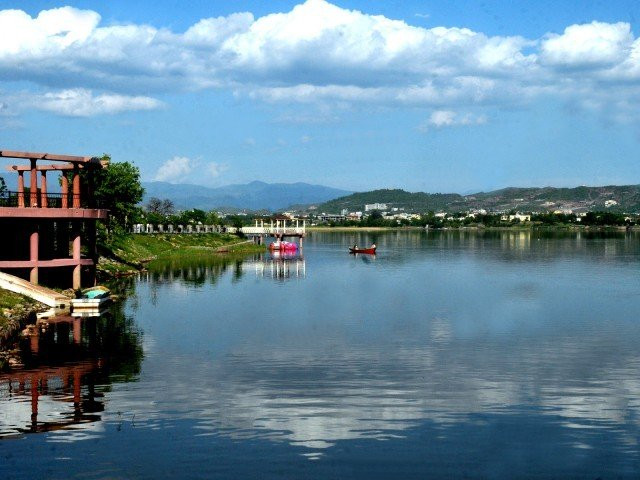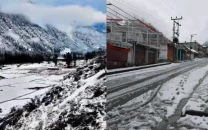Punjab to get four key tourist spots
Proposed areas include Mianwali, Kotli Sattian, Koh-e-Suleman and Attock Khurd

PHOTO: FILE
The Youth Affairs, Sports, Archeology and Tourism (YASAT) departments have already gotten approvals from the Punjab Planning and Development (P&D) department to hire consultants to conduct feasibility studies for the promotion of tourism in these areas. Tourism Development Corporation of Punjab (TDCP) Managing Director Ahmer Mallick said the corporation has prepared project proposals for the development of new tourist resorts in different areas of the province.
The corporation has proposed five sites for development of tourist resorts and tourist destinations, including Namal Lake, TallaGang – Mianwali; Kotli Sattian; Koh-eSuleman; Attock; and Panjinad. However, the approval for four sites has come in as the Punjinad project has been postponed. Responding to a question, Mallick highlights that the corporation has fixed a 20 to 36 week deadline after the issuance of the contract award letter for completion of the study.
"The corporation's internal studies and surveys indicate there is a huge tourism potential available at these sites. However, the actual decision will be made after receiving consultants' reports as the development of tourist resorts is just a small attraction. A successful tourist destination requires a whole range of services, including utilities, accessibility links, communication network, medical and shopping facilities, etc.," he says.
The MD adds that the corporation wants to execute these projects on a fast track basis.
Namal Lake
Official project documents made available to The Express Tribune highlight that the corporation has proposed a tourist resort/entertainment park near Namal Lake, Talla Gang Road and Mianwali.
It indicates that the Namal Lake is located in a corner of the Namal valley in Mianwali. It is a manmade lake that spreads over 5.5 square kilometres and is the largest of the many lakes that are spread across the valley.
The attraction of the lake is it's thousands of water fowl and it is the most prominent feature of Namal Valley. It is an attractive tourist resort as people from across the Namal Valley and beyond visit this place as a picnic spot. The lake also serves as a perfect habitat for various species of birds, like Russian ducks and Siberian cranes that migrate to the area during winters.
In addition, Namal Dam was built by the British government in 1913 to conserve water coming from numerous streams that eventually gave shape to what is now the lake.
It was aimed at creating a water resource for irrigating vast tracts of barren land to the western side of Mianwali. For over a century the dam has served as a constant source of precious water for farmers in the area.
It also serves as an exciting excursion point for tourists as Namal Lake winds through the mountains. Therefore, it attracts boating enthusiasts to test its waters from the lake up to the dam.
Attock Khurd
Attock is a place of great historic significance. Emperor Akbar the Great recognised the strategic importance of this area in 1581
and built the famous Attock Fort Complex.
The fall of the Mughal Empire in the eighteenth century saw the rise of Sikhs in Punjab and Durrani Afghans to the West. Attock became a battleground between two the contesting powers.
The British finally ended the feud by subjugating both Sikhs and Afghans in the nineteenth century. The Raj also introduced the rail line to the area and built the first permanent bridge in 1880 over the River Indus.
Begum ki Sarai, Kamran ki Baradari, Old Attock Bridge, Ghazi Brotha Dam, Railway Station of Attock Khurd, Tomb of Hazrat Yahya are also the most visited places by tourists. The corporation proposed recreational resorts on 100 kanals of land that are located near main Grand Trunk Road before Attock Bridge on the way to Peshawar.
The project had already been discussed in 2016 when it was decided that the corporation would to re-submit revised proposals to incorporate the engagement of a well-reputed international consultant for the preparation of the feasibility.
Kotli Sattian
Kotli Sttian has a healthy environment and weather. It touches the Kashmir territory on the East by bridging the River Jhelum and is the next door neighbour of Islamabad. The different areas of the subdivision vary greatly from each other.
The highest point is at Phofandi peak, by the east of Patriata, is over 7,035 feet above sea level. The lowest point is on the River Jhelum near Patton is only 1,587 feet above sea level. There are lots of tourist attractions such as Chewra Hill Top, Neela Sandh, Danoi Forest Rest House, Forest Watch Tower and Karore Park Way etc.
Document highlights Murree is Punjab's most popular hill station. It lies 65 km northeast of Islamabad at an altitude of 7,500 feet. A large number of tourists/visitors arrive in Murree every year. Over the last few decades, Murree has undergone unsustainable urban and commercial infrastructure development.
The downside is that this severe stress causes land sliding, hazards, shortage of adequate parking, solid waste management issues, traffic congestion, environmental pollution, deforestation, loss of biodiversity and poor livelihood.
Murree is already overcrowded and unable to cope with all the visitors, nor able to bear the load of new construction. Irregular and slouchy traffic is also a permanent problem with the area. Keeping in view the increasing flow of tourists, the government of the Punjab believes that new tourist destination can be developed.
The scenic landscape and easy accessibility of Kotli Sattian tehsil, just 36 km away from Murree, has lot of potential. The government highlights that the area can be developed as an alternate tourist destination to divert the tourist flow from Murree to Kotli Sattian.
Koh-e-Suleman
The Suleman Mountains or Koh-eSuleman, are the southern extension of the Hindukush mountain
range, located in southwestern Punjab, District Dera Ghazi Khan, northern Balochistan, and Khyber-Pakhtunkhwa.
Kohe-Suleman Range lies in Dera Ghazi Khan some 443 kilometres from Lahore and 95 kilometres from Multan. The Suleman Mountain Range separates the provinces of Balochistan and K-P, bordering Dera Ghazi Khan of Punjab and Dera Ismail Khan in KhyberPakhtunkhwa. The Range approaches the River Indus near Mithankot and Maari Hills Rajanpur District of Punjab.
The most famous site on Fort Munroe is Dames Lake which has many species of unique birds. A winding road leads to another top called Anari from where a nice view is available. There is a famous Christian Graveyard near Park with graves of two army soldiers and their families.
There are surrounding walls for its protection. There is not much rainfall in Fort Munroe and therefore its mountains are not green like Murree. There is also an issue of drinking water for which many plans have been made in the past. In recent times, road congestion is also becoming a problem during summer holidays.



















COMMENTS
Comments are moderated and generally will be posted if they are on-topic and not abusive.
For more information, please see our Comments FAQ